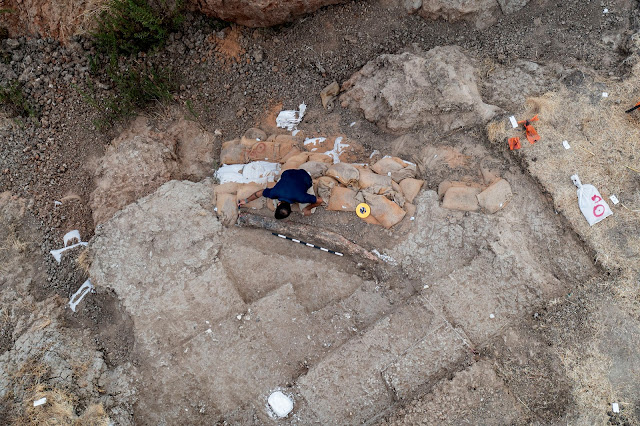An Israeli archaeologist works next to the recently discovered 2.5-meter-long tusk of an estimated 500,000-year-old straight-tusked elephant, near the city of Gedera, Israel, Wednesday, Aug. 31, 2022. Israel Antiquities Authority prehistorian Avi Levy, who headed the dig, said it was "the largest complete fossil tusk ever found at a prehistoric site in Israel or the Near East.
Credit: AP Photo/Tsafrir Abayov
Israeli archaeologists recently unearthed the titanic tusk of a prehistoric elephant near a kibbutz in southern Israel, a remnant of a behemoth once hunted by early people around half a million years ago.
The Israel Antiquities Authority announced Wednesday that the 2.5-meter (yard) long fossil belonging to the long-extinct straight-tusked elephant was found during a joint excavation with researchers from Tel Aviv University and Ben-Gurion University.
Israel Antiquities Authority prehistorian Avi Levy, who headed the dig, said it was "the largest complete fossil tusk ever found at a prehistoric site in Israel or the Near East."
The site was dated to the late lower paleolithic period, around 500,000 years ago, based on stone tools found in the vicinity, the antiquities authority said.
An Israeli archaeologist works next to the recently discovered 2.5-meter-long tusk of an estimated 500,000-year-old straight-tusked elephant, near the city of Gedera, Israel, Wednesday, Aug. 31, 2022. Israel Antiquities Authority prehistorian Avi Levy, who headed the dig, said it was "the largest complete fossil tusk ever found at a prehistoric site in Israel or the Near East.
Credit: AP Photo/Tsafrir Abayov
An Israeli archaeologist works next to the recently discovered 2.5-meter-long tusk of an estimated 500,000-year-old straight-tusked elephant, near the city of Gedera, Israel, Wednesday, Aug. 31, 2022. Israel Antiquities Authority prehistorian Avi Levy, who headed the dig, said it was "the largest complete fossil tusk ever found at a prehistoric site in Israel or the Near East.
Credit: AP Photo/Tsafrir Abayov
The tusk was found near a kibbutz on the central plain running parallel to Israel's Mediterranean coast. But half a million years ago, when the ancient elephant died, the now-arid terrain was likely a swamp or shallow lake, an ideal habitat for ancient hominids.
Recommend this post and follow
The Life of Earth




No comments:
Post a Comment
Stick to the subject, NO religion, or Party politics